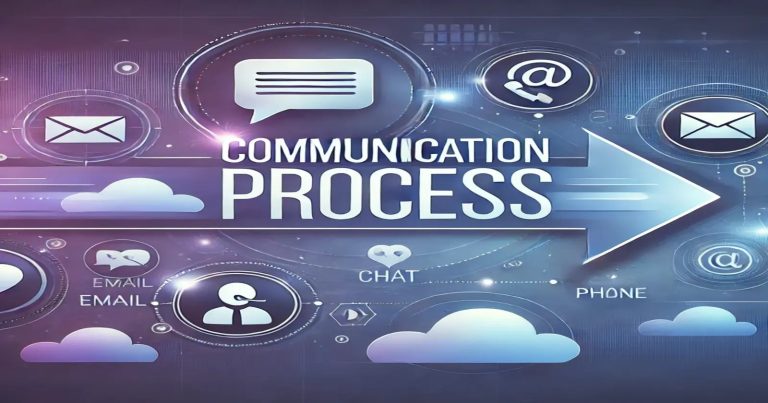Communication is the flow of information between people through a variety of channels. The communication process refers to those steps involved in the act of sending and receiving messages between two or more individuals. The process consists of encoding, transmitting, receiving, and decoding messages. Effective communication is essential for the achievement of any organization, community, or relationship. It ensures that all the parties involved receive the message well, hence improving collaboration and decision-making. Communication could be verbal or non-verbal, written, or digital, as it has different steps and elements that combine in order to provide the message.
Communication Process
There are a series of connected steps forming the communication process, which initiates when an individual or a group wishes to deliver a message to an individual or another group. All these include encoding, transmitting, receiving, and decoding of the messages. With this process, the sender can send over the message it wishes to reach the receiver so that it, in turn, gets to receive the preferred feedback.
- Sender: This is the person who has a thought or information intended to be conveyed.
- Encoding: In this process, the sender encodes the message; this is the transformation of the idea into a form that can be communicated, such as words, gestures, or visuals.
- Message: This is the actual message, the content of the communication, the information or idea the sender wants to pass.
- Medium: The medium is the channel through which the message is sent. This can be face-to-face communication, emails, phone calls, or even non-verbal communication.
- Receiver: The receiver is the person or group of people who receive the message and decode it.
- Decoding: The receiver decodes the message by interpreting the words or gestures and extracting meaning from the message.
- Feedback: Lastly, feedback is the process whereby the receiver gives a response to the sender regarding whether the message was received and understood.
- Noise: This refers to external factors that might distort or disrupt the message, including external physical noise, distractions, misunderstandings or differences in culture.
Inter Process Communication
Inter Process Communication refers to communication between different processes of a computer system. It is very important for the proper functioning of other tasks in a system since processes are meant to function together without problems. In any computer system, various processes undertake to collaborate to get the desired task done or share information, and IPC is the way through which this is accomplished.
OS or inter-application performs inter-process communications to exchange data, synchronize actions, and perform coordination of tasks. Unless its IPC mechanisms work properly, then the computer system will not be working as different processes cannot share information if they are working separately.
- Message Passing: Here, the processes communicate with each other by sending messages. The messages are usually kept in queues or buffers, through which the processes communicate with each other.
- Shared Memory: Shared memory is a region where several processes refer to the same block of memory. Shared memory allows processes to share data directly without requiring them to send messages to and from each other.
- Sockets: Sockets are a form of communication over a network. Two processes, usually running on different machines, communicate with each other by sending data over a socket, which is an endpoint for communication.
- Pipes: A pipe represents a way through which data is passed from one process to another process. In other words, pipes are one-way communication, and data flows along the pipe at one end and into the other. Pipes could be used intra-system or among systems.
Elements of Communication Process
The elements of communication are the components that form the communication process. Each element ensures that messages get passed and received effectively. These elements help the process function smoothly so that the sender and the receiver can clearly understand the message.
- Sender: The person or organization sending the message. A sender recognizes that there is information to be sent and makes the first contact by composing a message.
- Message: The communication process centres around the message. It is that which the sender wants to communicate. There are also many different formats in which messages come in. Some are verbal or non-verbal, while others are written, digital, and so on.
- Encoding: Encoding is a process in which the sender translates their thoughts or ideas into a message. In this process, the sender must determine the appropriate language, symbols, or actions to use to communicate the message appropriately.
- Medium: The medium is the medium by which the message travels. Different media are available depending on the context: face-to-face conversations, phone calls, emails, social media and many more. Each of the media is good in some situations.
- Receiver: The receiver is the one who is targeted by the person sending the message. They take the message into their minds, decode it, and derive a meaning from the message.
- Decoding: Decoding refers to how the receiver decodes the message. The receiver needs to pay attention to the message, understand what it says, and even prepare to respond.
- Feedback: Feedback refers to the receiver’s response to the sender about whether he interpreted the message. It is the most critical part of the communication process because it identifies whether the message is effective.
Process of Business Communication
Business communication is the skeleton of an organization since information moves smoothly from one person, group, and department to another. When business communication goes right, workers know what they ought to do, where they are going, and in what direction the organization is headed. There is less of a likelihood of misunderstandings; collaboration and efficiency are achieved.
The business communication process follows a similar pattern to the general communication process, but it also contains unique elements that are suited for the professional environment. The steps usually involved include the following:
- The process starts when the sender chooses the purpose of the communication. It could be information sharing, requesting action, making a decision, or addressing a problem.
- Once the purpose is established, the sender composes the message. The message must be well-organized, clear, and communicated with the right tone and proper level of formality.
- The sender then selects the proper medium for the message. The medium could be an email, a phone call, a formal report, or a face-to-face meeting, depending on the nature of the message and the audience.
- The message is then communicated through the selected channel. The sender, therefore, has to make sure that the message has reached the receiver. This can be done in person or even through email, among many other forms of communication media.
- The receiver receives the message and then decodes it. The receiver, therefore, needs to read carefully or listen to the message and understand its meaning.
Communication Skills
Good communication skills in both personal and professional fields create effective interaction. This involves the mixing of both verbal and non-verbal elements, like ensuring that one speaks clearly, listens attentively, and interprets various forms of body language. Communication helps in presenting ideas, solving conflicts, and relating to people.
- Active Listening: Active listening involves paying full attention to the speaker and understanding their message before responding. It requires focus and prevents misunderstandings by ensuring that the receiver understands the sender’s words accurately.
- Clarity: The ability to convey thoughts and ideas clearly is essential for effective communication. Using simple language and avoiding jargon helps ensure the receiver understands the message without confusion.
- Non-Verbal Communication: It includes facial expressions, gestures, and posture and conveys meaning along with the verbal message. Understanding these helps place words in the proper perspective.
- Empathy: Empathy refers to the acknowledgement and understanding of others’ feelings. This takes place when people are aware of how others feel and respond in a manner that supports trust and respect.
Barriers of Communication
Barriers to communication are factors that hinder the free flow of information between the sender and the receiver. They may be environmental, psychological, or a result of misunderstanding. All these barriers need to be overcome for effective communication.
- Language Barriers: A difference in language or dialect causes confusion and misunderstanding. Misunderstandings can occur when people speak different languages or use unfamiliar jargon.
- The noise barrier comprises emotional barriers like stress, anger, and other emotional factors that can usually hinder listening and responding abilities. Emotional states result in the distortion of the message or give a wrong impression to the receiver.
- Cultural barriers are differences in norms and values of cultures, leading to misunderstanding. What is appropriate in one culture might not be suitable for another; thus, how the message is conveyed and received changes.
- Perceptual barriers include distortion and biasing in perception. Individuals with preconceived notions or judgments will only filter information which does not meet the sender’s intent.
Communication Process FAQs
What is communication process?
The communication process refers to the stages that take place in the transmission and reception of messages.
What are the elements of the communication process?
The essential elements include the sender, message, encoding, medium, receiver, decoding, feedback, and noise. These are the elements of effective communication.
What is inter process communication?
Inter process communication (IPC) is the coordination of tasks and sharing of information across processes within an operating system or between various systems.
What are the barriers of communication?
Language barriers, emotional states, physical noise, cultural differences, and perceptual biases are examples of communication barriers that can distort or block effective communication and understanding.
What is business communication?
Business communication is the exchange of information in an organization or with external parties.


